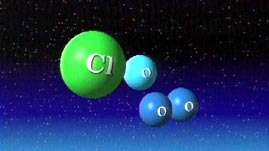Teachers' Domain - Digital Media for the Classroom and Professional Development
User: Preview

Source: NASA/Goddard Space Flight Center
It's remarkable to think that a compound renowned for its safety and stability in commercial products could have dramatically compromised the health of our planet, but that's just what chlorofluorocarbon (CFC) has done. This video segment adapted from NASA's Goddard Space Flight Center describes how CFCs, once widely used in refrigerators and aerosol cans, damaged the protective layer of ozone in our atmosphere.
Earth receives energy from the Sun in the form of electromagnetic radiation. A small portion of this radiation arrives as heat, while another small portion arrives as visible light. These two forms of energy make life on Earth possible. Another higher frequency form of electromagnetic radiation, called ultraviolet (UV) light, strikes Earth as well. However, rather than supporting life, UV light is known to damage the tissues, cells, and genetic material of living organisms and is linked to skin cancer, cataracts, and suppression of the immune system in humans.
Fortunately, gases in Earth's atmosphere absorb the majority of UV light and convert it to heat, rendering it harmless before it can reach Earth's surface. The gas responsible for most UV light absorption in the atmosphere is ozone. The molecules of this rare but critical gas are composed of three oxygen atoms. The oxygen used by living creatures in respiration has molecules composed of two oxygen atoms. When a photon of UV light strikes an ozone molecule, the energy splits the molecule into one two-atom molecule and one free oxygen atom, releasing heat in the process. At natural concentrations, atmospheric ozone absorbs up to 98 percent of the Sun's harmful UV radiation.
In 1974, scientists discovered that chlorine-based compounds called CFCs destroyed ozone in laboratory experiments. They hypothesized that this might also be occurring in the stratosphere, 10 to 17 kilometers (6 to 11 miles) above Earth's surface, where 90 percent of all ozone is found. Their hypothesis was based in part on the fact that CFCs are highly stable compounds capable of persisting in the atmosphere long after they had been released into the air.
By 1986, independent teams of scientists had confirmed the hypothesis. They found CFCs in the upper atmosphere and, more important, they discovered that the ozone concentrations had been dramatically depleted, especially over Earth's poles. Scientists now know that a single chlorine atom from a CFC molecule will, on average, destroy more than 100,000 ozone molecules before it ultimately becomes bound in a stable molecule.
Fortunately, news of the scientific discoveries about ozone depletion and its causes sparked an unprecedented international response. Since 1987, more than a hundred nations have signed resolutions in an effort to ultimately phase out the use of these compounds. As a result of international cooperation and the continued adherence to global agreements concerning ozone-depleting compounds, experts estimate that the ozone layer will recover by the middle of the twenty-first century.
 Loading Standards
Loading Standards Teachers' Domain is proud to be a Pathways portal to the National Science Digital Library.
Teachers' Domain is proud to be a Pathways portal to the National Science Digital Library.
